| Listing 1 - 10 of 32 | << page >> |
Sort by
|
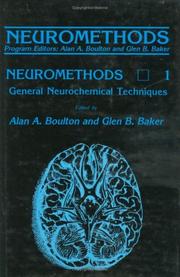
ISBN: 089603075X 1280836946 9786610836949 1592596061 Year: 1985 Publisher: Totowa, NJ : Humana Press : Imprint: Humana,
Abstract | Keywords | Export | Availability | Bookmark
 Loading...
Loading...Choose an application
- Reference Manager
- EndNote
- RefWorks (Direct export to RefWorks)
Biological techniques --- Neuropathology --- Animal biochemistry --- Human biochemistry --- Neurochemistry --- Neurophysiology --- Technique. --- Nervous system --- Neurobiology --- Physiology --- Biochemistry --- Neurosciences --- Neurosciences. --- Neural sciences --- Neurological sciences --- Neuroscience --- Medical sciences
Book
Abstract | Keywords | Export | Availability | Bookmark
 Loading...
Loading...Choose an application
- Reference Manager
- EndNote
- RefWorks (Direct export to RefWorks)
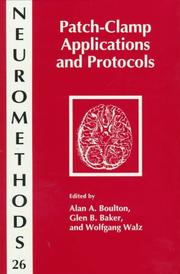
ISBN: 0896033112 9786610837151 1280837152 1592596312 Year: 1995 Publisher: Totowa, NJ : Humana Press : Imprint: Humana,
Abstract | Keywords | Export | Availability | Bookmark
 Loading...
Loading...Choose an application
- Reference Manager
- EndNote
- RefWorks (Direct export to RefWorks)
E. Neher and B. Sakman were the first to monitor the opening and closing of single ion channels and membranes by conductance measurements. In 1976, they used firepolished micropipets with a tip diameter of 3-5 pm to record currents from a small patch of the membrane of skeletal muscles, thereby decreasing background membrane noise. In order to reduce the dominant source of background noise-the leakage shunt under the pipet rim between m- the muscle membrane had to be treated brane and gla- enzymatically. Despite these early limitations, a new technique was born -the patch-clamp technique. The final break- through came in 1981 when the same authors, in collaboration with 0. P. Hamill, A. Marty, and F. J. Sigworth, developed the gigaohm seal. Not only did this improve the quality of recordings, it was now possible to gently pull the membrane patch with the attached pipet off the cell and study its trapped ion channels in isolation. Another offshoot of the gigaohm seal technique was the whole-cell patch-clamp technique, in which the patch is ruptured without breaking the seal. This technique is really a sophisticated voltage-clamp technique and also allows for the altering of cytoplasmic constituents if the experimenter so wishes. The first part of Patch-Clamp Applications and Protocols presents modern developments associated with the technology of patch-clamp electrodes, of cell-free ion channel recording, and of the whole-cell patch-clamp technique.
General biophysics --- Physiology of nerves and sense organs --- Patch-Clamp Techniques --- Electrophysiology --- Biophysics --- Physiology --- Cytological Techniques --- Biological Science Disciplines --- Clinical Laboratory Techniques --- Natural Science Disciplines --- Investigative Techniques --- Disciplines and Occupations --- Analytical, Diagnostic and Therapeutic Techniques and Equipment --- Patch-clamp techniques (Electrophysiology) --- Methodology. --- Animal electricity --- Bioelectricity --- Electricity, Animal --- Electrobiology --- Neurology --- Electricity --- Clamping, Patch (Electrophysiology) --- Patch-clamp recording (Electrophysiology) --- Patch-clamp technique (Electrophysiology) --- Patch clamping (Electrophysiology) --- Physiological effect --- Technique --- Neurosciences. --- Neural sciences --- Neurological sciences --- Neuroscience --- Medical sciences --- Nervous system

ISBN: 0896031608 9786610837052 1280837055 1592596193 Year: 1990 Publisher: Totowa, NJ : Humana Press : Imprint: Humana,
Abstract | Keywords | Export | Availability | Bookmark
 Loading...
Loading...Choose an application
- Reference Manager
- EndNote
- RefWorks (Direct export to RefWorks)
The development of neurophysiology, the study of the activity of living nervous tissue, has relied heavily on the techniques of electrophysiology. This emphasis is revealed in volumes 14 and 15 of this series, which show how electrophysiological techniques can be applied to research topics ranging from ion channels to human behavior. Kitai and Park show how cellular neurophysiology can be related to classical neuroanatomy, an important basis for any type of functional analysis. Wonderlin, French, Arispe, and Jones describe new (single channel) and more traditional (whole cell) techniques for studying the role of ion channels in cellular pr- esses, a field that is currently developing very rapidly. An exciting nontraditional approach to the study of cellular electrophysiology is discussed by Hopp, Wu, Xiao, Rioult, London, Zecevic, and Cohen in their paper on optic measurement of membrane pot- tials. Humphrey and Schmidt offer a thoughtful review of the uses and limitations of the technique of recording extracellular unit potentials in the brain. Hoffer presents an introduction to a field that is of great interest but is technically very difficult-the reco- ing from cells and axons in the spinal cord and peripheral nervous system in freely moving animals. An electrophysiological approach to the analysis of the neural mechanisms of normal behavior is presented by Halgren in a wide-ranging review of the field of evoked potentials in humans.
Physiology of nerves and sense organs --- Neurophysiology --- Electrophysiology --- Research --- Methodology. --- Animal electricity --- Bioelectricity --- Electricity, Animal --- Electrobiology --- Nervous system --- Physiology --- Neurology --- Electricity --- Neurobiology --- Physiological effect --- Neurosciences. --- Neural sciences --- Neurological sciences --- Neuroscience --- Medical sciences
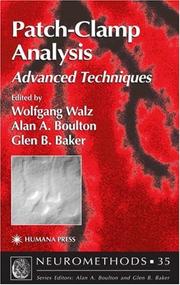
ISBN: 1588290131 9786610830619 1280830611 1592592767 Year: 2002 Publisher: Totowa, NJ : Humana Press : Imprint: Humana,
Abstract | Keywords | Export | Availability | Bookmark
 Loading...
Loading...Choose an application
- Reference Manager
- EndNote
- RefWorks (Direct export to RefWorks)
The use of the patch pipet has moved from a specialized to a mainstream method that can be combined with other techniques to perform complex and novel operations. In Patch-Clamp Analysis: Advanced Techniques, Wolfgang Walz and his colleagues bring together a team of leading academic researchers to describe in reproducible detail all the most important patch-clamp methods. Beginning with updated basic patch-clamp techniques, these hands-on experts present the newest developments, ranging from fast external solution switching and the switching of the pipet solution during recording, to the loose-patch, the perforated-patch, and the patch-cram detection technique. Coverage of these advanced techniques combines their molecular biology and imaging to produce the patch pipet with RT-PCR and fluorometric techniques. All the methods included describe the theoretical background, offer complete startup help, and provide tips on solving common problems and analyzing data. Comprehensive and highly practical, Patch-Clamp Analysis: Advanced Techniques surveys all the major applications that involve patch pipets and sets the stage for the emergence of today's new applications involving genomics, proteomics, and sophisticated imaging techniques.
General biophysics --- Physiology of nerves and sense organs --- Electronic books. -- local. --- Electrophysiology -- Methodology. --- Patch-clamp techniques (Electrophysiology). --- Patch-Clamp Techniques --- Electrophysiology --- Physiology --- Biophysics --- Cytological Techniques --- Biological Science Disciplines --- Clinical Laboratory Techniques --- Natural Science Disciplines --- Investigative Techniques --- Analytical, Diagnostic and Therapeutic Techniques and Equipment --- Disciplines and Occupations --- Patch-clamp techniques (Electrophysiology) --- Methodology. --- Clamping, Patch (Electrophysiology) --- Patch-clamp recording (Electrophysiology) --- Patch-clamp technique (Electrophysiology) --- Patch clamping (Electrophysiology) --- Animal electricity --- Bioelectricity --- Electricity, Animal --- Electrobiology --- Neurology --- Electricity --- Technique --- Physiological effect --- Neurosciences. --- Neural sciences --- Neurological sciences --- Neuroscience --- Medical sciences --- Nervous system
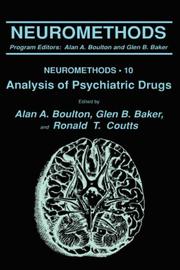
ISBN: 0896031217 9786610837014 1280837012 1592596150 Year: 1988 Volume: vol 10 Publisher: Clifton, N.J. Humana Press
Abstract | Keywords | Export | Availability | Bookmark
 Loading...
Loading...Choose an application
- Reference Manager
- EndNote
- RefWorks (Direct export to RefWorks)
In this volume, we hope to cover the malor techniques that are presently being used to analyze the actions of drugs used in psyc- atry. The contributors of the chapters are active researchers who have considerable practical experience with the techniques they are describing, and the emphasis in the chapters is on three types of psychiatric drugs, namely antidepressants, antipsychotics, and anxiolytics. The first chapter, by Curry and Yu, discusses protein binding of psychotropic drugs, with special reference to equilibrium ana- sis as the method of assessment and to lipophilicity correlations. Since many of the drugs used in treating psychiatric disorders are bound extensively to protein, this aspect is of great importance with regard to their therapeutic actions and toxicity, Basic mat- matical models, techniques for the study of protein binding, molecular aspects of protein binding, binding in relation to lipophilicity, indirect approaches to measurement of the fraction of drug bound, the function of protein binding, and tissue binding are among the topics discussed. Chapter 2, by Norman and B- rows, deals with the principles of isotope derivative assays and their applications to antidepressants and antipsychotics; extensive protocols are provided. The third chapter, by Cooper, deals with analysis by gas-liquid chromatography. Sample collection and storage, extraction procedures, column selection, use of internal standards, types of detectors, techniques of application, and - plications to specific drugs are among the topics discussed.
Antidepressants --- Tranquilizing drugs --- Analysis. --- Antianxiety agents --- Antianxiety drugs --- Anxiolytic agents --- Anxiolytic drugs --- Anxiolytics --- Ataractic drugs --- Minor tranquilizers --- Minor tranquilizing agents --- Minor tranquilizing drugs --- Tranquilizers --- Antidepressive agents --- Energizers, Psychic --- Psychic energizers --- Psychotropic drugs --- Depression, Mental --- Chemotherapy --- Analysis --- Antidepressants - Analysis. --- Tranquilizing drugs - Analysis. --- Neurosciences. --- Neural sciences --- Neurological sciences --- Neuroscience --- Medical sciences --- Nervous system
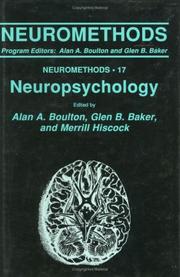
ISBN: 0896031330 9786610837083 128083708X 1592596223 Year: 1990 Volume: vol 17 Publisher: Totowa, NJ : Humana Press : Imprint: Humana,
Abstract | Keywords | Export | Availability | Bookmark
 Loading...
Loading...Choose an application
- Reference Manager
- EndNote
- RefWorks (Direct export to RefWorks)
If one envisages neuroscience as a pyramid, with the more mole- lar disciplines forming the base and the more integrative d- ciplines positioned above, then neuropsychology clearly would be near the tip. Neuropsychology seeks to find order in the ultimate product of all neural systems, namely behavior, and to relate that product to its neural substrate. Relationships between brain and behavior are sought, but reductionistic explanations are eschewed. Attempting to “explain” complex behaviors in terms of neuronal activity is no more satisfying than attempting to “explain” artificial intelligence in terms of voltages within a computer’s central pr- essing unit. If one is to comprehend the functioning of either the brain or the digital computer, one must know something about not only the structure and mechanics of the device, but also the prin- ples according to which components of the device are organized and the context in which the device is operating (e.g., environm- tal inputs and stored information).
Behavioral neurology --- Clinical neuropsychology --- Klinische neuropsychologie --- Neurology [Behavioral ] --- Neuropsychological tests --- Neuropsychologie clinique --- Neuropsychologische tests --- Tests neuropsychologiques --- Neuropsychological tests. --- Clinical neuropsychology. --- Neurology, Behavioral --- Neuropsychological assessment --- Neuropsychological evaluation --- Tests, Neuropsychological --- Clinical psychology --- Neuropsychology --- Neurologic examination --- Psychological tests --- Neurosciences. --- Neural sciences --- Neurological sciences --- Neuroscience --- Medical sciences --- Nervous system
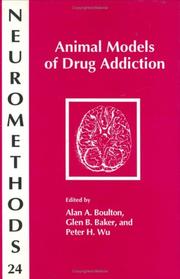
ISBN: 0896032175 1592596290 Year: 1992 Volume: 24 Publisher: Totowa, NJ : Humana Press : Imprint: Humana,
Abstract | Keywords | Export | Availability | Bookmark
 Loading...
Loading...Choose an application
- Reference Manager
- EndNote
- RefWorks (Direct export to RefWorks)
to the Animal Models Volumes This volume describes animal models of drug addiction. Because of increasing public concern over the ethical treatment of animals in research, we felt it incumbent upon us to include this general preface in order to indicate why we think further research using animals is necessary. Animals should only be used when suitable alternatives are not available, and humans can only be experimented upon in severely proscribed circumstances. Alternative procedures using cell or tissue culture are inadequate in any models requiring assessments of behavioral change or of complex in vivo p- cesses. However, when the distress, discomfort, or pain to the animals outweighs the anticipated gains for human welfare, the research is not ethical and should not be carried out. It is imperative that each individual researcher examine his/ her own research from a critical moral standpoint before eng- ing in it, and take into consideration the animals’ welfare as well as the anticipated gains. Furthermore, once a decision to p- ceed with research is made, it is the researcher’s responsibility to ensure that the animals’ welfare is of prime concern in terms of appropriate housing, feeding, and maximum reduction of any uncomfortable or distressing effects of the experimental conditions.
Alcoholism --- Drug abuse --- Alcohol, Ethyl --- Disease Models, Animal --- Drug Tolerance --- Models, Genetic --- Substance Dependence --- Animal models --- pharmacology --- physiopathology --- Ethanol --- Substance-Related Disorders --- Pharmacology --- Models, Biological --- Alcohols --- Mental Disorders --- Animal Diseases --- Diseases --- Models, Animal --- Pharmacological Processes --- Biological Science Disciplines --- Organic Chemicals --- Physiological Processes --- Investigative Techniques --- Natural Science Disciplines --- Models, Theoretical --- Pharmacological Phenomena --- Psychiatry and Psychology --- Physiological Phenomena --- Chemicals and Drugs --- Disciplines and Occupations --- Analytical, Diagnostic and Therapeutic Techniques and Equipment --- Phenomena and Processes --- Substance Abuse Disorders --- Psychiatry --- Health & Biological Sciences --- pharmacology. --- physiopathology. --- Models, Genetic. --- Animal models. --- Disease Models, Animal. --- Drug Tolerance. --- Neurosciences. --- Psychiatry. --- Medicine and psychology --- Mental health --- Psychology, Pathological --- Neural sciences --- Neurological sciences --- Neuroscience --- Medical sciences --- Nervous system
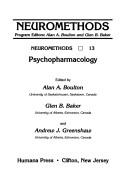
ISBN: 1280837047 9786610837045 1592596185 0896031292 Year: 1989 Publisher: Totowa, NJ : Humana Press : Imprint: Humana,
Abstract | Keywords | Export | Availability | Bookmark
 Loading...
Loading...Choose an application
- Reference Manager
- EndNote
- RefWorks (Direct export to RefWorks)
The study of drug effects on behavior is truly a confluence of streams of neuroscience research. The material in this volume covers a broad range of methodology representative of practically the entire scope of psychopharmacology for conscious animals. The contributions in this book represent careful evaluations by experts who were invited to participate because of their excellent practical application of research design and methodology. In each case, a particularly useful and well-written contribution has been forthcoming, and should serve either as a valuable introduction to developing researchers or as a practical reference to those active in the field. The material is arranged in an intuitive hierarchy. This arrangement is based on what are ostensibly increasing levels of integrated activity of the nervous system and, therefore, increasing levels of behavioral integration. Nevertheless, as all of the areas covered are rather detailed in their levels of intrinsic complexity, this arrangement of chapters does not imply successively more intricate problems. The reader will find some overlap between chapters, but little interdependence, i.e., each may be read as a separate or as an integral part of the volume.
Psychopharmacology --- Pharmacology --- Psychiatric Somatic Therapies --- Behavioral Sciences --- Behavioral Disciplines and Activities --- Biological Science Disciplines --- Health Occupations --- Psychiatry and Psychology --- Disciplines and Occupations --- Natural Science Disciplines --- Pharmacy, Therapeutics, & Pharmacology --- Health & Biological Sciences --- Methodology --- Research --- Natural Sciences --- Physical Sciences --- Discipline, Natural Science --- Disciplines, Natural Science --- Natural Science --- Natural Science Discipline --- Physical Science --- Science, Natural --- Science, Physical --- Sciences, Natural --- Sciences, Physical --- Health Professions --- Health Occupation --- Health Profession --- Occupation, Health --- Occupations, Health --- Profession, Health --- Professions, Health --- Biologic Sciences --- Biological Science --- Science, Biological --- Sciences, Biological --- Biological Sciences --- Life Sciences --- Biologic Science --- Biological Science Discipline --- Discipline, Biological Science --- Disciplines, Biological Science --- Life Science --- Science Discipline, Biological --- Science Disciplines, Biological --- Science, Biologic --- Science, Life --- Sciences, Biologic --- Sciences, Life --- Proxemics --- Behavioral Science --- Proxemic --- Science, Behavioral --- Sciences, Behavioral --- Psychiatric Somatic Therapy --- Somatic Therapies, Psychiatric --- Therapies, Psychiatric Somatic --- Somatic Therapy, Psychiatric --- Therapy, Psychiatric Somatic --- Pharmacologies --- Pharmaceutical Preparations --- Behavioral pharmacology --- Drugs --- pharmacology --- Psychotropic effects --- Neurosciences. --- Neural sciences --- Neurological sciences --- Neuroscience --- Medical sciences --- Nervous system
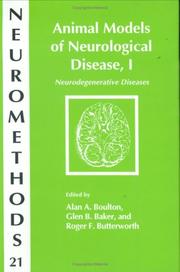
ISBN: 128083711X 9786610837113 1592596266 0896032086 0896032116 9786610837120 1280837128 1592596274 Year: 1992 Publisher: Totowa, NJ : Humana Press : Imprint: Humana,
Abstract | Keywords | Export | Availability | Bookmark
 Loading...
Loading...Choose an application
- Reference Manager
- EndNote
- RefWorks (Direct export to RefWorks)
to the Animal Models Volumes This and several other volumes in the Neuromethods series will describe a number of animal models of neuropsychiatric disorders. Because of increasing public concern over the ethical treatment of animals in research, we felt it incumbent upon us to include this general preface to these volumes in order to indicate why we think further - search using animals is necessary and why animal models of psychiatric disorders, in particular, are so important. We recognize that animals should only be used when suitable alternatives are not available. We think it self-e- dent, however, that humans can only be experimented upon in severely proscribed circumstances and alternative pro- dures using cell or tissue culture are inadequate in any models requiring assessments of behavioral change or of complex in vivo processes. However, when the distress, discomfort, or pain to the animals outweighs the anticipated gains for human welfare, then the research is not ethical and should not be carried out. It is imperative that each individual researcher examine his/her own research from a critical moral standpoint - fore engaging in it, taking into consideration the animals’ welfare as well as the anticipated gains. Furthermore, once a decision to proceed with research is made, it is the researcher’s responsibility to ensure that the animals’ w- fare is of prime concern in terms of appropriate housing, feeding, and maximum reduction of any uncomfortable or distressing effects of the experimental conditions, and that these conditions undergo frequent formalized monitoring.
Nervous system -- Diseases -- Animal models. --- Nervous system --- Diseases --- Models, Biological --- Models, Animal --- Animal Diseases --- Disease Models, Animal --- Nervous System Diseases --- Models, Theoretical --- Investigative Techniques --- Analytical, Diagnostic and Therapeutic Techniques and Equipment --- Medicine --- Neurology --- Health & Biological Sciences --- Animal models --- Animal models. --- Organs (Anatomy) --- Neurosciences --- Neurosciences. --- Neural sciences --- Neurological sciences --- Neuroscience --- Medical sciences
| Listing 1 - 10 of 32 | << page >> |
Sort by
|

 Search
Search Feedback
Feedback About
About Help
Help News
News